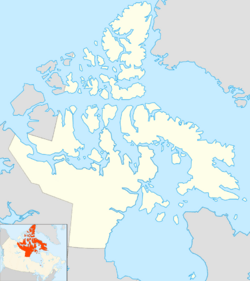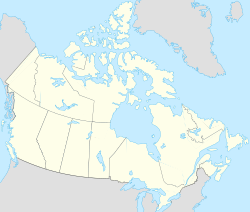Johns Island (Nunavut) facts for kids
| Geography | |
|---|---|
| Location | Lake Hazen |
| Coordinates | 81°49′08″N 71°03′41″W / 81.818815°N 71.061265°W |
| Archipelago | Canadian Arctic Archipelago |
| Administration | |
|
Canada
|
|
| Nunavut | Nunavut |
| Region | Qikiqtaaluk |
| Demographics | |
| Population | Uninhabited |
Johns Island is a small, uninhabited island located in the far northern part of Canada. It's found within the Qikiqtaaluk Region of Nunavut, which is one of Canada's three territories. What makes Johns Island special is its unique location: it's an island inside a lake, and that lake is on an even bigger island!
This "island within an island" is found in Lake Hazen, which is the largest lake north of the Arctic Circle. Lake Hazen itself is located on Ellesmere Island, one of the largest islands in the world. Johns Island is also part of Quttinirpaaq National Park, a huge protected area known for its Arctic wilderness.
Contents
Wildlife on Johns Island
Even though Johns Island is small and uninhabited by people, it is home to some amazing Arctic wildlife. The island and the areas nearby are important breeding grounds for certain birds.
Long-tailed Jaegers
One of the most interesting birds found breeding on Johns Island is the long-tailed jaeger. These birds are known for their long tail feathers and their strong flying skills. They are a type of seabird that lives in the Arctic regions.
Life Cycle and Reproduction
Long-tailed jaegers travel long distances to reach their breeding grounds in the Arctic. They often choose remote and quiet places like Johns Island to lay their eggs and raise their young. The Arctic summer provides plenty of daylight for them to hunt and find food for their chicks. They typically build nests on the ground, often in open areas where they can spot predators easily.
What do Jaegers Eat?
Long-tailed jaegers are skilled hunters. Their diet mainly consists of small rodents, especially lemmings, which are common in the Arctic tundra. They also eat birds, eggs, and sometimes fish. During the breeding season, finding enough food is crucial for the survival of their chicks.
Location and Environment
Johns Island's location in Lake Hazen on Ellesmere Island means it experiences an extreme Arctic climate. The area has very cold winters and short, cool summers. Despite the harsh conditions, the lake and surrounding land support a unique ecosystem.
Quttinirpaaq National Park
Johns Island is part of Quttinirpaaq National Park, which is Canada's second-most northerly national park. The park protects a vast area of Arctic desert, glaciers, and mountains. It's a place of incredible natural beauty and an important habitat for many Arctic animals. The park's name, "Quttinirpaaq," means "land at the top of the world" in the Inuktitut language.
Lake Hazen's Importance
Lake Hazen is a significant feature of the park. It's a deep freshwater lake that plays a role in the local climate and supports aquatic life, even though it's frozen for much of the year. The lake's presence helps create a slightly warmer microclimate in its immediate surroundings, which can be beneficial for wildlife like the long-tailed jaegers.



